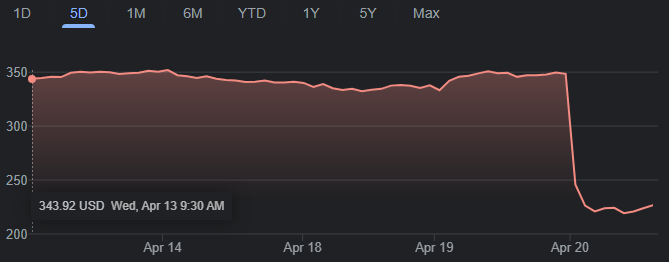# Netflix's Recent Subscriber Loss: A Trend Towards Decline?
Written on
Chapter 1: The Downward Spiral of Netflix
Netflix experienced a significant blow recently, marking its first subscriber loss in a decade. This unexpected decline of 225,000 users—despite an anticipated gain of 2.5 million—has sent shockwaves through the stock market. In just one day, the company's shares plummeted by 35%, wiping out over $50 billion in market capitalization.

This raises the question: what led to this downturn, and what does it mean for Netflix moving forward?
Section 1.1: The Price Hike Dilemma
Reflecting on my experience, I joined Netflix when it was just $7.99, offering DVDs through the mail. It was a refreshing alternative to costly cable subscriptions and rental stores with their late fees. However, the service has consistently raised its prices by $1 to $2 approximately every two years. Currently, we face a monthly fee of $15.49 (or $20 for 4K access).
To illustrate this, let's look at the pricing changes over the last five years:
- October 2017: $9.99 to $10.99
- January 2019: $10.99 to $12.99
- October 2020: $12.99 to $13.99
- January 2021: $13.99 to $15.49
In total, this represents a staggering 50% increase in just five years, nearly doubling the original price. Amid rising inflation and fears of a recession, many users are starting to reconsider their subscriptions.
Section 1.2: Content Quality and Availability
Netflix often justifies these price increases with promises of more engaging content. However, users are increasingly finding it challenging to locate quality shows. While the platform focuses heavily on its Originals—which are typically less expensive to produce—many of these series leave much to be desired.
The reality is that only a small fraction of Netflix Originals are genuinely impressive; many fall flat, and viewers are frequently inundated with subpar options, making it hard to discover standout content.
Subsection 1.2.1: The Cancellation Conundrum
Netflix has also developed a troubling pattern of launching original series with great fanfare, only to cancel them after just one or two seasons if they don’t perform well. This practice frustrates loyal viewers who are left hanging after investing time in a series that abruptly ends, often on a cliffhanger.
Additionally, many Originals follow predictable formulas, allowing viewers to foresee plot developments after watching just a few shows.

Section 1.3: Flawed Recommendation Systems
The platform's decision to remove the user-driven 5-star rating system has also disappointed many subscribers. This rating system was a valuable tool for discovering content based on user preferences. Instead, Netflix now relies on a "trending" list that often highlights low-quality options, which can mislead viewers into thinking they’re selecting something worthwhile.
Back in 2008, when my friends and I began cutting cable, we relished the freedom from paying for channels we never watched. Now, as we subscribe to multiple streaming services, our bills are creeping back up to similar levels.
Chapter 2: The Future of Streaming
In light of these challenges, Netflix's CEO, Reed Hastings, acknowledges that pricing is becoming a significant concern for consumers. The company is considering introducing a lower-cost model that includes advertisements, which ironically brings it closer to the traditional cable model it once sought to disrupt. This move contradicts Netflix’s original commitment to an ad-free experience.
Moreover, Netflix is tightening its grip on password sharing, which is causing further discontent among users who feel the service is becoming less user-friendly.
As Netflix evolves, it risks becoming yet another platform filled with a vast array of shows but lacking in truly engaging content.
Section 2.1: The Expectations Dilemma
It’s essential to consider that we often place unrealistic expectations on American companies. We anticipate continuous growth and revenue increases from successful businesses. Netflix is now facing a saturation point in the market, with competition intensifying and its financial stability being tested.
Despite these challenges, Netflix still delivers value; I personally enjoy shows like "The Parisian Agency" and various crime documentaries. However, I find myself questioning the worth of my subscription, particularly when faced with frequent price hikes.
A new trend is emerging where users subscribe to services in bursts, consuming content for a few months before switching to another platform. This "nomadic streaming" approach might signal the end of long-term commitments to any single service.
As we navigate these changes, it may be time to reconsider our subscriptions to services that fail to meet our expectations and perhaps even reduce our screen time.